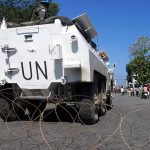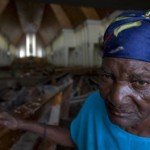The Humanitarian Myth
By Richard Seymour
Socialist Worker
WITHIN DAYS of Haiti suffering an earthquake registering 7.0 on the Richter scale, the U.S. government had sent thousands of 82nd Airborne troops and Marines, alongside the super-carrier USS Carl Vinson.

U.S. troops push back a crowd of Haitians waiting for food and water outside the Port-au-Prince airport (Sgt. Jeremy Lock)
By this Sunday, a total of more than 20,000 U.S. troops were scheduled to be operating in Haiti, both on land and in the surrounding seas. “We are there for the long term,” explained Alejandro Wolff, the U.S. ambassador to the United Nations. The justification for sending troops is that there is a “security” crisis, which soldiers have to deal with in order to facilitate the distribution of aid.
The situation was and remains a needful one. The Haitian interior minister estimates that as many as 200,000 may have died as a result of the quake, and 2 million have been left homeless. Potable water is extremely scarce, and was so even before the quake. Only half a million have found the makeshift camps that provide some food and water, but have such poor sanitation that they are fostering diarrhea. Clinics are overwhelmed by the injured survivors, estimated to number a quarter of a million.
Since the arrival of the troops, however, several aid missions have been prevented from arriving at the airport in Port-au-Prince, that the U.S. has commandeered. France and Caribbean Community have both made their complaints public, as has Médecins Sans Frontières on five separate occasions. UN World Food Program flights were also turned away on two consecutive days. Benoit Leduc, MSF’s operations manager in Port-au-Prince, complained that U.S. military flights were being prioritized over aid flights. Now, U.S. ships have encircled Haiti in order to prevent refugees escaping and fleeing to the United States.
Not only has aid been obstructed and escape blocked, but what aid does arrive was at first not being delivered, and then only in small amounts. Some five days after the earthquake struck, BBC News reporter Nick Davis described how aid had just started “trickling through.” While aid was arriving in Haiti “in large amounts,” some “bottlenecks” prevented the bulk of it from being distributed.
Asked why the U.S. was not using its air power to deliver aid to areas unreachable by road, Defense Secretary Robert Gates maintained that this would result in riots. The writer Nelson Valdes has described how U.S. and UN authorities advised aid workers not to distribute relief independently, as they would be subject to “mob attacks.”
Eyewitnesses have repeatedly described how rescue workers are scarce on the ground, and relief nowhere to be seen. Hospitals that are functioning despite the wreckage complain of having no painkillers with which to operate on patients with serious injuries. Dr. Evan Lyon of Partners in Health explained that:
[I]n terms of supplies, in terms of surgeons, in terms of aid relief, the response has been incredibly slow. There are teams of surgeons that have been sent to places that were “more secure,” where they have 10 or 20 doctors and 10 patients. We have a thousand people on this campus who are triaged and ready for surgery, but we only have four working [operating rooms], without anesthesia and without pain medications. And we’re still struggling to get ourselves up to 24-hour care.
In effect, the U.S. has staged an invasion of Haiti, under the pretext of providing security for humanitarian aid, and in doing so has prevented the delivery of humanitarian aid. With Haitians in a desperate condition, and the UN-supervised government in dire straits, Washington has sent the International Monetary Fund to offer a $100 million loan, on the proviso that public wages be frozen.
The “security” operation, meanwhile, proceeds apace. As well as U.S. troops, thousands more UN police have been sent to Haiti. Already, UN troops, alongside the Haitian police, have been responsible for several killings, as they have opened fire on starving earthquake survivors who dared to try to retrieve the means of survival from shops and other locations. The US has also insisted that the Haitian government pass an emergency decree authorizing curfews and martial law. Secretary of State Hillary Clinton said that the decree “would give the government an enormous amount of authority, which in practice they would delegate to us.”
This process has been facilitated by a flood of alarmist and often racist reporting about “mobs,” “looters” and “gangs” causing a “security crisis.” A “security crisis” validates a repressive response.
The Haitian police have justified their brutal massacres of “looters”–those securing their right to life in desperate circumstances–by telling the media that thousands of prisoners have escaped from the country’s jails, and are running amok, posing a threat to vulnerable citizens. Police have been attempting to whip up fear among earthquake survivors, organising them into vigilantes to attack the escaped prisoners. However, as many as 80 percent of Haiti’s prisoners have never been charged with a crime. “Gangs”–in the vernacular of Washington, the White House press corps and Haiti’s business lobby, the Group of 184–happens to be a synonym for Lavalas activists.
For all the headlines, moreover, there is strikingly little actual violence taking place. Most of the stories of violence center on episodes of “looting,” and most such instances involve desperate people procuring the means of survival. Aid workers also contradict the image of mobs on the attack purveyed by the media and U.S. officials. Abi Weaver, spokesperson for the American Red Cross, confirmed that “we haven’t had any security issues at all.”
“There are no security issues,” said Dr. Evan Lyon. “We’ve been circulating throughout the city until 2:00 and 3:00 in the morning every night, evacuating patients, moving materials. There’s no UN guards. There’s no US military presence. There’s no Haitian police presence. And there’s also no violence. There is no insecurity.” In fact, Lt. Gen. Ken Keen, deputy commander of U.S. Southern Command, maintains that there is less violence in Haiti now than before the earthquake.
So if there is no insecurity, and if the US military intervention is actually obstructing aid, what becomes of the pretext for the invasion?
Humanitarian intervention
Notwithstanding this extraordinary performance, many American commentators actually approve of the U.S. response.
Jonathan Dobrer, of the American Jewish University in Bel Air, declared himself “almost sinfully proud of America.” Steven Cohen of Columbia University enthused on the liberal Huffington Post that “We Have Reason to be Proud of the American Response in Haiti.” New York Times op-ed contributor Jonathan M. Hansen called on the U.S. to go further, and use the Guantánamo gulag as a base for “humanitarian intervention” in Haiti.
Indeed, the label “humanitarian” is regularly applied to U.S. actions in Haiti. It is important to recall, therefore, that the overthrow of Haiti’s elected government in 2004 and the subsequent occupation was itself originally cast as a humanitarian intervention of sorts.
Aristide, so the story went, had governed incompetently, his rule characterized by such corruption and violence as to generate countrywide disturbances. In recognition of his inability to govern, he supposedly “resigned” and fled the country. Filling the gap created by the absence of legitimate authority, concerned members of the “international community” prevailed upon the United Nations to send troops into Haiti and facilitate the development of democratic institutions.
Matters are a little more prosaic and grubby than this uplifting scenario would suggest. The U.S. had begun cutting aid programs to Haiti when Aristide was elected with an overwhelming mandate for his second term in 2000. The result was that the national budget was cut in half, and gross domestic product shrank by a quarter in the ensuing period.
The pro-U.S. opposition group, Convergence Démocratique, declared that it would not accept the results and instead began to agitate against the incoming government. Paramilitary attacks, beginning in the summer of 2001, were carried out by former death squad members and organized criminals acting in association with Haiti’s business community. Former army personnel such as Guy Philippe, an admirer of Augusto Pinochet, were organized by the U.S. under the rubric of the Fronte pour la Libération et la Reconstruction Nationale (FLRN).
By February 2004, a full-blown insurgency had been launched, and had begun to take control of large parts of the country. None of the Lavalas rulers had military experience, and they were not prepared to arm and mobilize the population.
Aristide, far from being a violent or incompetent ruler as his critics suggest, was eventually defeated because he was not prepared to violently repress an opposition that was explicitly organizing for his overthrow. His administrations had actually been highly effective in a number of areas, despite considerable pressures from the U.S. and the Haitian ruling class.
Lavalas can be credited with reducing infant mortality from 125 to 110 per thousand live births, bringing illiteracy down from 65 percent to 45 percent and slowing the rate of new HIV infections. It was obliged by the U.S. to accept “structural adjustment” programs, but did what it could to soften the blow by maintaining subsidies, implementing some land reforms, and promulgating certain social programs. It legislated against the exploitation of children as unpaid servants in wealthy homes. It reformed the notoriously labyrinthine judiciary and put several death squad members on trial. It also managed to extract some taxes from the rich, in the face of strenuous resistance.
For these humanitarian accomplishments, Aristide had to go. Once the dregs of former genocidaires and the criminal fraternity had wrought sufficient destruction across the country, the U.S. Marine Corps abducted Aristide on September 29, 2004. The initial line given to the press by James Foley, the U.S. ambassador to Haiti, was that it was a rescue mission. The U.S. had stepped in, concerned for Aristide’s welfare, and he had resigned voluntarily.
As soon as Aristide got hold of a telephone, however, he informed every news outlet that would listen that he had been kidnapped by U.S. forces. He was not permitted to return to Haiti, and an occupation began under a UN mandate, enforced by MINUSTAH troops. A new regime was imposed that locked up political activists and priests, and thousands were killed either by MINUSTAH soldiers directly or by gangs operating under their authority. Democracy Now! reported that a study published in The Lancet found:
[D]uring the 22-month period of the U.S.-backed Interim Government, 8,000 people were murdered in the greater Port-au Prince area alone. Thirty-five thousand women and girls were raped or sexually assaulted, more than half of the victims were children…Those responsible for the human rights abuses include criminals, the police, United Nations peacekeepers and anti-Lavalas gangs.
Meanwhile, the democratic process that the UN was supposed to oversee has resulted in elections in which the country’s most popular political party, Lavalas, are not allowed to participate. The recent senatorial and congressional elections saw turnouts depressed to as little as 10 percent as a result. This shambolic process has made life easier for Haiti’s ruling class, and the multinationals operating in Haiti, but by no stretch of the imagination is it “humanitarian.”
The point of highlighting this background is to note that, contrary to some short-sighted commentary–like Jonathan Dobrer: “We come, we help, and we don’t stay”–the U.S. has a bloody recent history in Haiti and a well-defined set of goals in the country, including the desire to finish off Lavalas and create a benevolent investment climate for business.
The belief that the U.S. is behaving in a humanitarian manner in Haiti is at best myopic. At worst, it buys into the racist mythologies about Haiti that have been on prominent display in headlines and news copy for over a week now.
Paternalism and racism
The paternalistic assumptions behind the calls for ‘humanitarian intervention’ have sometimes been starkly expressed. Thus, the conservative columnist Eric Margolis lauds the history of American colonial rule in Haiti: “[T]he U.S. occupation is looked back on by many Haitians as their “golden age.” The Marine Corps proved a fair, efficient, honest administrator and builder. This era was the only time when things worked in Haiti.”
Purporting to oppose imperialism, Margolis insists that “genuine humanitarian intervention” is “different,” and calls for Haiti to be “temporarily administered by a great power like the U.S. or France.” He writes: “U.S. administration of Haiti may be necessary and the only recourse for this benighted nation that cannot seem to govern itself.”
Similarly, right-wing New York Times columnist David Brooks, decrying the supposed “progress-resistant cultural influences” that he maintains holds Haiti back, calls for the U.S. to “promote locally-led paternalism.” “We’re all supposed to politely respect each other’s cultures,” he complains. “But some cultures are more progress-resistant than others, and a horrible tragedy was just exacerbated by one of them.”
To overcome this cultural handicap, Brooks recommends finding gurus who would promote a culture of achievement and responsibility–as opposed to the irresponsible, chaotic, “Voodoo-ridden” culture that he identifies as Haiti’s major problem.
It is unnecessary to dignify such caricatures by considering them as empirical hypotheses. However, it should be noted that neither author gives the slightest consideration to the persistent efforts of the U.S. government to frustrate the rise of popular, democratic movements such as Lavalas, nor to the IMF-imposed programs which saw real wages fall by 50 percent between 1980 and 1990, and which resulted in overpopulated slums and a failing rural economy.
Nor do they acknowledge the brutality of the UN occupation. While Margolis acknowledges that America’s colonial rule was “sometimes brutal,” his understatement is verging on euphemism when he omits to discuss the killing of 15,000 people as Haiti’s rebels, known as Cacos, were suppressed.
Nor does he mention the humiliating system of forced labor that was imposed on Haitians under U.S. rule, or the fact that the gendarmerie built up under U.S. occupation became the organized basis for later dictatorships that would blight Haiti. In short, both writers bring to bear astonishingly little understanding of the country whose fate they are discussing so cavalierly.
However, what is of interest in these caricatures is the genus of imperial ideology that they relate to. Margolis is an old-school conservative (he describes himself as an Eisenhower Republican). He recalls in his phrases the manifest-destinarianism of William McKinley, who argued that the conquest and colonization of the Philippines was justified since Filipinos “were unfit for self-government.”
In the imperial language of the U.S. and Europe in this period, self-government was conceived of either as a cultural state that only white people had achieved, or as a technology that only white people could use. Woodrow Wilson, the invader of Haiti, explained that the Philippines could not be given self-government by the United States, since “it is a form of character and not a form of constitution.” Self-government is a cultural state attained after a period of discipline that “gives people self-possession, self-master, the habit of order.”
For Wilson, only the “nobler races”–namely Europeans and white Americans–had achieved that state. Margolis would not be so explicitly racist, but his subtext is not the less subtle for that.
Brooks, though, is a neoconservative. As such, he brings to bear that tradition’s paternalism, its concern with developing good patriarchal families, and particularly its culturalist reading of social institutions.
In this view, government and other institutions reflect an accumulation of cultural practices that have survived through generations. Capitalism and liberal democracy are thus the result of cultural influences such as Judeo-Christian values. The ability to govern oneself as a society is also said to be a result of cultural attributes that are generally found to be lacking in America’s opponents. These discrete cultures do not necessarily correspond to older notions of ‘race’, but they perform an analogous function in permitting privileged U.S. commentators to applaud the conquest of other societies.
Thus, at the height of the Vietnam War, the “godfather” of neoconservatism, Irving Kristol, argued that it was correct for the U.S. to support a right-wing dictatorship since “South Vietnam, like South Korea, is barely capable of decent self-government under the very best of conditions.” Like the Black families that Daniel Patrick Moynihan famously diagnosed as suffering from a “tangle of pathologies,” these people lacked the exquisite cultural refinements that made white Americans so successful.
These are exceptionally explicit commentaries. Most of those lauding American actions are unlikely to be as cynical or brazen as Brooks and Margolis. Yet when 20,000 U.S. troops arrive in a wrecked island country, and begin obstructing aid and beefing up “security” while people die in the wreckage of thirst and starvation, only the willfully purblind or those trapped in the assumptions of the “civilizing mission,” could construe it as a “humanitarian intervention.”
Source: Socialist Worker | Richard Seymour is the author of The Liberal Defense of Murder.







Comments
The Humanitarian Myth — No Comments